What are the Precautions for Stainless Steel Drilling, Reaming and Boring?
Processing technology of stainless steel and design of relevant cutting tool parameters. Compared with the processing of ordinary steel materials, there are great differences. Now let's talk about the specific processing technology.
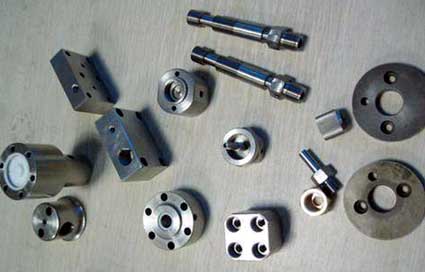
1, Drilling processing
In the drilling process, the hole processing is not easy because of the poor thermal conductivity of the stainless steel material and the small elastic modulus. In order to solve the hole machining problem of stainless steel, it is best to select the appropriate tool material to determine the geometric parameters of the tool and the cutting amount of the tool. Kangding Metal company's main products are rotary top, screw, axis processing, CNC lathe processing, tool handle, tool rod, chuck connector. When drilling stainless steel, the drill usually has a drill bit made of W6Mo5Cr4V2Al or W2Mo9Cr4Co8. The disadvantage of this type of drill bit is that it is expensive and not very good to buy. However, when using the common W18Cr4V common standard high speed steel drill bit. Because there will be shortcomings such as small apex angle and too large swarf, it is not possible to discharge the hole in time, and the cutting fluid cannot cool the drill bit in time. In addition, the poor thermal conductivity of stainless steel materials leads to an increase in the cutting temperature concentrated on the cutting edge. It is easy to burn and break the two flanks and the main edge, and shorten the service life of the bit.

1>, tool geometry parameters
When drilling with W18Cr4V ordinary high-speed steel drill bit, the cutting force and cutting temperature are concentrated on the drill tip. In order to improve the durability of the cutting part of the drill bit, the apex angle can be appropriately increased, and the apex angle is generally selected from 135° to 140°. An increase in the apex angle will also reduce the rake angle of the outer edge and narrow the drill cuttings to facilitate chip evacuation. However, after the top angle is increased, the chisel edge of the drill bit becomes wider, resulting in an increase in cutting resistance. Therefore, the chisel chisel edge must be ground. After the grinding, the oblique angle of the chisel edge is 47°~55°, and the rake angle of the chisel edge is 3°~5°. When grinding the chisel edge, the cutting edge and the cylindrical corner should be rounded to increase the chisel edge strength.
Because the elastic modulus of stainless steel is small, the elastic recovery of metal under chip layer is large, and the work hardening is serious in the process of processing. Too small a back angle will accelerate the wear of the flank of the drill bit, and increase the cutting temperature and reduce the life of the drill bit. Therefore, the relief angle should be appropriately increased, but the back angle is too large, which will make the main edge of the drill bit thin and reduce the rigidity of the main edge, so the relief angle should be 12°-15°. In order to narrow the cuttings and facilitate the removal of cuttings, it is necessary to open staggered chip grooves on the two flanks of the bit.
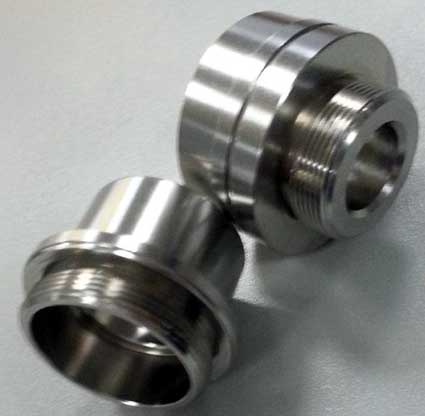
2>, cutting amount selection
When drilling, the choice of cutting amount should be based on the basic point of reducing the cutting temperature. Because high-speed cutting will increase the cutting temperature, and high cutting temperatures will increase tool wear, so the most important part of the cutting amount is the cutting speed. In general, the cutting speed is preferably 12 to 15 m/min. The feed rate has little effect on the tool life, but the feed selection is too small to cut the tool in the hardened layer and aggravate the wear; If the feed amount is too large, the surface roughness will be deteriorated. In combination with the above two factors, the feed amount is preferably selected from 0.32 to 0.50 mm/r.
3>, cutting fluid selection
In order to reduce the cutting temperature during drilling, an emulsion can be used as the cooling medium.
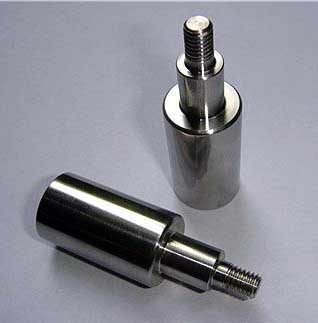
2, Reaming Processing
1>Tool geometry parameters
Most of the reaming of stainless steel materials uses carbide reamer. The structure and geometric parameters of the reamer are different from those of a normal reamer. In order to enhance the strength of the teeth and prevent chip clogging during reaming, the number of teeth of the reamer is generally small. The rake angle of the reamer is generally 8 ° ~ 12 °, but in some specific cases, in order to achieve high-speed reaming, 0 ° ~ 5 ° rake angle can also be used; The back angle is generally 8 ° ~ 12 °; The choice of lead angle varies depending on the hole. Generally, the through hole is 15° to 30°, and the through hole is 45°;
When reaming, in order to discharge chips forward, the inclination angle of the edge can also be increased appropriately. The inclination angle of the edge is generally 10° to 20°. The width of edge bandwidth is 0.1-0.15 mm. The inverted cone on the reamer should be larger than the ordinary reamer, the hard alloy reamer is generally 0.25 ~ 0.5mm / 100mm, the high speed steel reamer is 0.1 ~ 0.25mm / 100mm; The length of the reamer correction part is generally 65% to 80% of the ordinary reamer, and the length of the cylindrical part is 40% to 50% of the ordinary reamer.
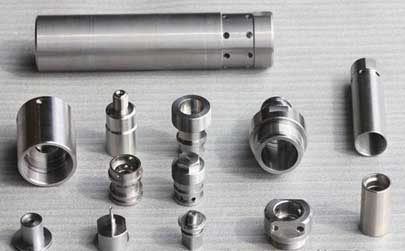
2>, reaming volume selection
The feed amount during reaming is 0.08~0.4mm/r, and the reaming speed is 10~20m/min. The coarse hinge allowance is generally 0.2 to 0.3 mm, and the fine hinge allowance is 0.1 to 0.2 mm. Carbide tools should be used for rough hinges and high speed steel tools for fine hinges.
3>, reaming fluid selection
When the stainless steel material is reamed, the full loss system oil or molybdenum disulfide can be used as the cooling medium.
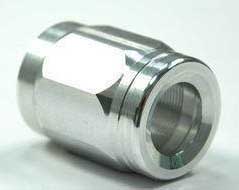 3, Stainless steel boring processing
3, Stainless steel boring processing
1>, tool material selection
Due to the high cutting force and high cutting temperature when machining stainless steel parts, the tool material should be selected as high-quality YC or YG-type hard alloy with high thermal conductivity. YT14 and YT15 carbide inserts are also available for finishing. Due to the characteristics of such materials, the toughness is large and the work hardening is serious. Chips produced by cutting these materials in the form of unit chips will cause tool vibration and easily cause slight collapse of the blade. Therefore, the first consideration for ceramic cutting tools when cutting such material parts is microscopic toughness.
Currently Sialon is a better choice, especially for alpha/beta Sialon materials. Because of its excellent resistance to high temperature deformation and diffusion wear, it has been successfully applied to cutting nickel-based alloys, and its life is far longer than that of Al2O3-based ceramics. In addition, SiC whisker reinforced ceramics are also a very effective tool material for cutting stainless steel or nickel based alloys.
For the processing of hardened parts of such materials, CBN (cubic boron nitride) inserts can be used. CBN hardness is second only to diamond, hardness can reach 7000 ~ 8000HV, so the wear resistance is very high. Compared with diamond, CBN has the outstanding advantage that heat resistance is much higher than diamond, up to 1200 ° C, and can withstand high cutting temperatures. In addition, its chemical inertness is very large, and it does not play a chemical role with the iron group metal at 1200-1300 °C. It is therefore very suitable for processing stainless steel materials. Its tool life is dozens of times that of cemented carbide or ceramic tools.
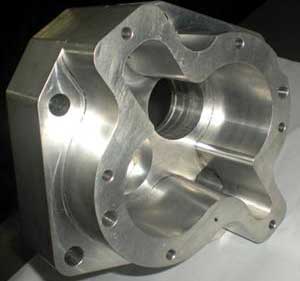
2. Boring tool geometry parameters
The geometric parameters of the boring tool play an important role in the cutting performance. In order to make the cutting light and smooth, the carbide tool should adopt a large front angle to improve the tool life. Generally, when roughing, the front angle is 10 ° ~ 20 °, and the semi-finishing is 15 ° ~ 20 °;Take 20 ° ~ 30 ° during finishing. The selection of the lead angle is based on the fact that when the process system is rigid, it can take 30 ° ~ 45 °; If the process system is poor in rigidity, take 60 to 75 °. When the ratio of the length to the diameter of the workpiece exceeds 10 times, it is 90°.
When boring stainless steel with ceramic tools, in most cases, ceramic tools are cut with a negative rake angle. This is conducive to strengthening the blade and giving full play to the superiority of the ceramic tool with high compressive strength. The size of the back angle directly affects the tool wear and has an effect on the edge strength. It is generally selected from 5° to 12°. The change in the lead angle affects the variation of the radial and component cutting forces as well as the cutting width and the thickness of the cutting. Because the vibration of the process system is extremely unfavorable to the ceramic tool, the choice of the lead angle is beneficial to reduce this vibration, generally 30 ° ~ 75 °. When CBN is selected as the tool material, the tool geometry parameters are 0°~10° for the rake angle, 12°~20° for the back angle, and 45°~90° for the main angle.
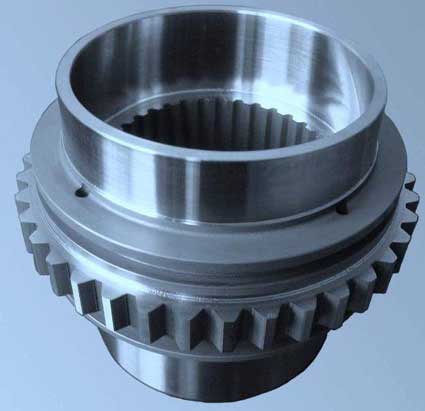
3>. The roughness value of the rake face should be small when sharpening
To avoid the phenomenon of chip sticking. The front and back flank of the tool should be carefully sharpened to ensure a small roughness value, thus reducing chip outflow resistance and avoiding chip sticking.
4>, keep the sharp edge of the tool
The cutting edge of the tool should be sharp to reduce work hardening. The amount of feed and the amount of backing knife should not be too small to prevent the cutting of the tool in the hardened layer and affect the service life of the tool.
5>, Pay attention to grinding of chip breaking groove
Because stainless steel chips have strong and tough characteristics, the grinding of chip breaking groove on tool rake face should be appropriate, so that chip breaking, chip holding and chip removal are convenient in the cutting process.
6>, choose the cutting amount
According to the characteristics of stainless steel materials, it is advisable to use low speed and large feed for cutting.
When using ceramic tools for boring, the reasonable choice of cutting amount is one of the keys to fully exploit the performance of ceramic tools. When cutting ceramic tools, the cutting amount can be selected according to the relationship between wear durability and cutting amount; For interrupted cutting, the reasonable cutting amount should be determined according to the damage law of the tool. Due to the superior heat resistance and wear resistance of ceramic knives, the influence of cutting amount on tool wear life is smaller than that of cemented carbide tools.
In general, when machining with ceramic tools, the feed rate is most sensitive to the damage of the tool. Therefore, according to the nature of the workpiece material, under the premise of machine power, process system stiffness and blade strength. When boring stainless steel parts, choose a high cutting speed, a large backing knife and a relatively small feed.

1, Drilling processing
In the drilling process, the hole processing is not easy because of the poor thermal conductivity of the stainless steel material and the small elastic modulus. In order to solve the hole machining problem of stainless steel, it is best to select the appropriate tool material to determine the geometric parameters of the tool and the cutting amount of the tool. Kangding Metal company's main products are rotary top, screw, axis processing, CNC lathe processing, tool handle, tool rod, chuck connector. When drilling stainless steel, the drill usually has a drill bit made of W6Mo5Cr4V2Al or W2Mo9Cr4Co8. The disadvantage of this type of drill bit is that it is expensive and not very good to buy. However, when using the common W18Cr4V common standard high speed steel drill bit. Because there will be shortcomings such as small apex angle and too large swarf, it is not possible to discharge the hole in time, and the cutting fluid cannot cool the drill bit in time. In addition, the poor thermal conductivity of stainless steel materials leads to an increase in the cutting temperature concentrated on the cutting edge. It is easy to burn and break the two flanks and the main edge, and shorten the service life of the bit.

1>, tool geometry parameters
When drilling with W18Cr4V ordinary high-speed steel drill bit, the cutting force and cutting temperature are concentrated on the drill tip. In order to improve the durability of the cutting part of the drill bit, the apex angle can be appropriately increased, and the apex angle is generally selected from 135° to 140°. An increase in the apex angle will also reduce the rake angle of the outer edge and narrow the drill cuttings to facilitate chip evacuation. However, after the top angle is increased, the chisel edge of the drill bit becomes wider, resulting in an increase in cutting resistance. Therefore, the chisel chisel edge must be ground. After the grinding, the oblique angle of the chisel edge is 47°~55°, and the rake angle of the chisel edge is 3°~5°. When grinding the chisel edge, the cutting edge and the cylindrical corner should be rounded to increase the chisel edge strength.
Because the elastic modulus of stainless steel is small, the elastic recovery of metal under chip layer is large, and the work hardening is serious in the process of processing. Too small a back angle will accelerate the wear of the flank of the drill bit, and increase the cutting temperature and reduce the life of the drill bit. Therefore, the relief angle should be appropriately increased, but the back angle is too large, which will make the main edge of the drill bit thin and reduce the rigidity of the main edge, so the relief angle should be 12°-15°. In order to narrow the cuttings and facilitate the removal of cuttings, it is necessary to open staggered chip grooves on the two flanks of the bit.

2>, cutting amount selection
When drilling, the choice of cutting amount should be based on the basic point of reducing the cutting temperature. Because high-speed cutting will increase the cutting temperature, and high cutting temperatures will increase tool wear, so the most important part of the cutting amount is the cutting speed. In general, the cutting speed is preferably 12 to 15 m/min. The feed rate has little effect on the tool life, but the feed selection is too small to cut the tool in the hardened layer and aggravate the wear; If the feed amount is too large, the surface roughness will be deteriorated. In combination with the above two factors, the feed amount is preferably selected from 0.32 to 0.50 mm/r.
3>, cutting fluid selection
In order to reduce the cutting temperature during drilling, an emulsion can be used as the cooling medium.

2, Reaming Processing
1>Tool geometry parameters
Most of the reaming of stainless steel materials uses carbide reamer. The structure and geometric parameters of the reamer are different from those of a normal reamer. In order to enhance the strength of the teeth and prevent chip clogging during reaming, the number of teeth of the reamer is generally small. The rake angle of the reamer is generally 8 ° ~ 12 °, but in some specific cases, in order to achieve high-speed reaming, 0 ° ~ 5 ° rake angle can also be used; The back angle is generally 8 ° ~ 12 °; The choice of lead angle varies depending on the hole. Generally, the through hole is 15° to 30°, and the through hole is 45°;
When reaming, in order to discharge chips forward, the inclination angle of the edge can also be increased appropriately. The inclination angle of the edge is generally 10° to 20°. The width of edge bandwidth is 0.1-0.15 mm. The inverted cone on the reamer should be larger than the ordinary reamer, the hard alloy reamer is generally 0.25 ~ 0.5mm / 100mm, the high speed steel reamer is 0.1 ~ 0.25mm / 100mm; The length of the reamer correction part is generally 65% to 80% of the ordinary reamer, and the length of the cylindrical part is 40% to 50% of the ordinary reamer.

2>, reaming volume selection
The feed amount during reaming is 0.08~0.4mm/r, and the reaming speed is 10~20m/min. The coarse hinge allowance is generally 0.2 to 0.3 mm, and the fine hinge allowance is 0.1 to 0.2 mm. Carbide tools should be used for rough hinges and high speed steel tools for fine hinges.
3>, reaming fluid selection
When the stainless steel material is reamed, the full loss system oil or molybdenum disulfide can be used as the cooling medium.

1>, tool material selection
Due to the high cutting force and high cutting temperature when machining stainless steel parts, the tool material should be selected as high-quality YC or YG-type hard alloy with high thermal conductivity. YT14 and YT15 carbide inserts are also available for finishing. Due to the characteristics of such materials, the toughness is large and the work hardening is serious. Chips produced by cutting these materials in the form of unit chips will cause tool vibration and easily cause slight collapse of the blade. Therefore, the first consideration for ceramic cutting tools when cutting such material parts is microscopic toughness.
Currently Sialon is a better choice, especially for alpha/beta Sialon materials. Because of its excellent resistance to high temperature deformation and diffusion wear, it has been successfully applied to cutting nickel-based alloys, and its life is far longer than that of Al2O3-based ceramics. In addition, SiC whisker reinforced ceramics are also a very effective tool material for cutting stainless steel or nickel based alloys.
For the processing of hardened parts of such materials, CBN (cubic boron nitride) inserts can be used. CBN hardness is second only to diamond, hardness can reach 7000 ~ 8000HV, so the wear resistance is very high. Compared with diamond, CBN has the outstanding advantage that heat resistance is much higher than diamond, up to 1200 ° C, and can withstand high cutting temperatures. In addition, its chemical inertness is very large, and it does not play a chemical role with the iron group metal at 1200-1300 °C. It is therefore very suitable for processing stainless steel materials. Its tool life is dozens of times that of cemented carbide or ceramic tools.

2. Boring tool geometry parameters
The geometric parameters of the boring tool play an important role in the cutting performance. In order to make the cutting light and smooth, the carbide tool should adopt a large front angle to improve the tool life. Generally, when roughing, the front angle is 10 ° ~ 20 °, and the semi-finishing is 15 ° ~ 20 °;Take 20 ° ~ 30 ° during finishing. The selection of the lead angle is based on the fact that when the process system is rigid, it can take 30 ° ~ 45 °; If the process system is poor in rigidity, take 60 to 75 °. When the ratio of the length to the diameter of the workpiece exceeds 10 times, it is 90°.
When boring stainless steel with ceramic tools, in most cases, ceramic tools are cut with a negative rake angle. This is conducive to strengthening the blade and giving full play to the superiority of the ceramic tool with high compressive strength. The size of the back angle directly affects the tool wear and has an effect on the edge strength. It is generally selected from 5° to 12°. The change in the lead angle affects the variation of the radial and component cutting forces as well as the cutting width and the thickness of the cutting. Because the vibration of the process system is extremely unfavorable to the ceramic tool, the choice of the lead angle is beneficial to reduce this vibration, generally 30 ° ~ 75 °. When CBN is selected as the tool material, the tool geometry parameters are 0°~10° for the rake angle, 12°~20° for the back angle, and 45°~90° for the main angle.

3>. The roughness value of the rake face should be small when sharpening
To avoid the phenomenon of chip sticking. The front and back flank of the tool should be carefully sharpened to ensure a small roughness value, thus reducing chip outflow resistance and avoiding chip sticking.
4>, keep the sharp edge of the tool
The cutting edge of the tool should be sharp to reduce work hardening. The amount of feed and the amount of backing knife should not be too small to prevent the cutting of the tool in the hardened layer and affect the service life of the tool.
5>, Pay attention to grinding of chip breaking groove
Because stainless steel chips have strong and tough characteristics, the grinding of chip breaking groove on tool rake face should be appropriate, so that chip breaking, chip holding and chip removal are convenient in the cutting process.
6>, choose the cutting amount
According to the characteristics of stainless steel materials, it is advisable to use low speed and large feed for cutting.
When using ceramic tools for boring, the reasonable choice of cutting amount is one of the keys to fully exploit the performance of ceramic tools. When cutting ceramic tools, the cutting amount can be selected according to the relationship between wear durability and cutting amount; For interrupted cutting, the reasonable cutting amount should be determined according to the damage law of the tool. Due to the superior heat resistance and wear resistance of ceramic knives, the influence of cutting amount on tool wear life is smaller than that of cemented carbide tools.
In general, when machining with ceramic tools, the feed rate is most sensitive to the damage of the tool. Therefore, according to the nature of the workpiece material, under the premise of machine power, process system stiffness and blade strength. When boring stainless steel parts, choose a high cutting speed, a large backing knife and a relatively small feed.





